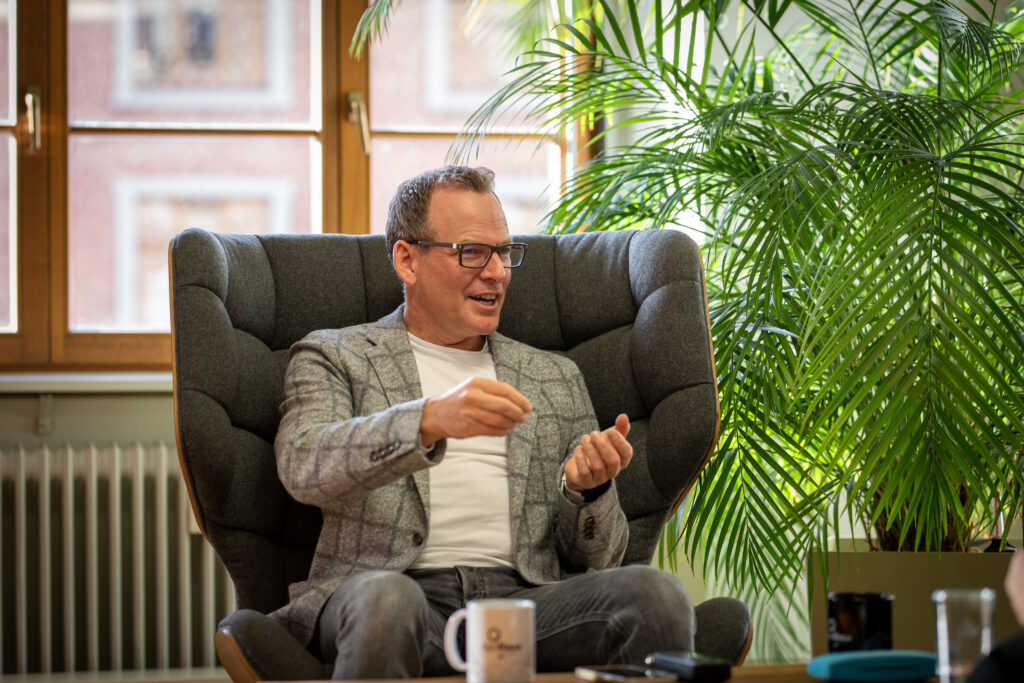SAP AppHaus was founded 10 years ago for customer co-innovation projects. Andreas Hauser, SVP and head of SAP AppHaus Network, discusses what makes it unique, how it has scaled over the last decade, what innovation is, and reflects on his leadership style.
Q: What is at the heart of the SAP AppHaus approach?
A: SAP AppHaus has always been a front-runner for incubating new products, technology, and methods. To date, we’ve completed more than 1,000 customer co-innovation projects. But what makes us unique is our human-centered approach to innovation driven by a combined methodology of design thinking and architecture thinking.
At an SAP AppHaus customer workshop, people from IT, the business, and end users of our customers often come together for the first time ever! And this is where the dialogue begins – with the end users at the heart of the process. The core of our methodology is, first and foremost, to understand the end user’s problem. Finding a solution to that problem guides us from the first iteration to the go-live. And this is why, I believe, customers love to work with us – because we help them understand their problems before we come up with a solution and then help them solve it with SAP technologies. Making innovation real and getting it into the hands of end users is our mantra.
One of the issues I see time and time again in some organizations is a tendency to build, sell, or talk about products before understanding the customer problem. Generative AI is a case in point. With all new technologies, people often believe that technology alone will solve all their problems. But generative AI cannot solve everything. To this end, we’ve created a new Generative AI Explore workshop. The goal is to identify use cases where generative AI is the perfect solution and can create high business value for our customers.
What sparks change and innovation?
Experience drives change. Ten years ago, our customers wanted to have an Amazon-like experience with their SAP apps, and this started to shift the focus to end-user experience and expectations. What, we had to ask ourselves, do customers and their end users need?
Creativity and new ideas are useless if they’re not implemented. If we implement something that nobody needs, then there’s no value. And with no value, there’s no innovation.
Innovation is creativity multiplied by execution to increase business value. True innovation adds business value and customers benefit from it. That’s innovation.
How do you measure the success of SAP AppHaus? What are your KPIs?
Our focus on getting customers on stage to tell their story is unrelenting because customer success stories are our currency.
Customers talking about their successful implementations and how they use SAP solutions is the most powerful way to change perception about SAP products. With our human-centered approach, we demonstrate that we support SAP’s activities and ambitions in different ways: by helping to sell our software and services, drive adoption of our products, improve products based on customer feedback, and promote SAP as the innovation partner of choice. Our customer relationships are long-term – from accompanying customers to go-live, to helping them work successfully with their new SAP solution, to helping them with further improvements and innovations.
SAP AppHaus focuses on use cases where customers want to innovate at speed and have a solution in a matter of months or even weeks. Getting those customers live on the stage at events like SAP Sapphire and SAP TechEd is a major performance indicator for SAP AppHaus.
At SAP TechEd this year, for example, our customer success stories included AMD, Doehler, Henkel, Pif Paf, and Orbia. Let’s not forget, this is always the result of a cross-team effort that involves organizations from across SAP. All organizations contribute their outstanding business and technical knowledge to the overall success. The additional skills SAP AppHaus brings to the table are methodologies to understand the needs of people (user research) and visualize the potential solutions (UX design) as well as the skills to execute a customer project on a holistic basis.

How is SAP AppHaus scaling its success?
As long ago as 2016, we had to think about how we could scale our approach and create even more customer success stories, which led to us launching our first pilot with a partner based in Amsterdam, the Netherlands. Today SAP AppHaus Network has 22 locations and teams – three run by SAP and 19 by partners – with more than 15,000 employees. There is an SAP AppHaus partner on every continent! Our most recent partner addition is NEORIS in Mexico.
All partners joined the network as single companies. But over time, the network has evolved, with its members teaming up across the globe to form a community of collaborating companies. What unites them is their joint vision to make innovation real by applying a human-centered approach that starts with people, not technology. To give an example, the network has a very active enterprise architect community with about 120 members currently focusing on generative AI.
SAP AppHaus typically works with local SAP market units to identify smaller, agile partners that can provide a deep understanding of the local culture and a focus on that region or country.
What makes SAP AppHaus special?
In the team, there’s a culture of openness, a lack of hierarchy, space for disagreements, and time to reach a consensus. Above all, I would say that the team is a learning organization. The team has the amazing power of reinventing itself every two years or so to embrace new products, trends, and methodologies.
What have you learned about leadership during your time at SAP AppHaus?
As a leader, the process of learning how to lead the team the right way is an ongoing process. I absolutely believe in empowering employees to be their best selves and to reach their potential. But the flip side of empowering employees is that employees need to take accountability. The role of a leader is to find the balance.
I have had a very good experience with just being authentic, telling it like it is, and putting my ego aside. It is all about the team and its focus on customer success. I am a person just like everybody else. And, yes, I play a certain role, but like others I too have had my challenges.
I’ve led SAP AppHaus since it was founded 10 years ago. During that time, I had cancer twice. It gave me a chance to reinvent myself. Today, I am thankful for this experience because it helped me find a better work-life balance and become a better leader. My key takeaway is this: focus on the topics that really matter, get them done, and give others the space to do what they are best at.
Top image courtesy of SAP employee Karsten Hohage



